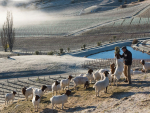While the latter of these is still a major issue today, the other two have been somewhat nullified by the drop in yields in the 2012 vintage. Now wineries will be facing concerns over whether they have enough wine to meet market demand, rather than worrying about how they are going to clear their tanks of surplus stock.
At the NZW Vintage Review meetings held around the country, CEO Philip Gregan spoke about the impact the lower than average vintage would have on the industry overall. The bad news is, if sales continue over the next 12 months, the way they did in the last 12 months, we would be short by 45 million litres. Who would have predicted that at vintage last year?
Of course there are positives to this scenario. If Mother Nature hadn’t conspired to thwart the grower’s attempts to reach maximum yields, what would that extra 45 million litres have been used for? Bulk wine? If so, then the shortfall is a positive.
Will the drop mean New Zealand is entering a phase where the demand for our wines outstrips supply? Then that also is a positive. But only if the prices paid rise in accordance.
Unfortunately that may be a harder task to achieve, than the increased sales attained in the 12 months to the end of June 2012.
The GFC isn’t over. One look at the situation in Europe is enough to verify that.
People the world over are still hurting financially and everyone knows that
wine is a discretionary spend. The prices paid for our wine in the past few years have fallen from the golden highs pre 2008.
Admittedly they are starting to show signs of rising in the UK, but elsewhere there are very few markets where the price paid currently is above the price paid four years ago.
So the task in front of the industry now, is to build the value component, on the back of a drop in volume.
There is one factor that will help that scenario – the quality of the 2012 vintage. Yields may have been down, but the near perfect autumn conditions meant those lower crops were able to ripen at their leisure.
The ensuing wines have got winemakers very excited.
The next 12 months will be all important ones, as New Zealand works to re-establish its reputation as a high quality producer of premium wines, rather than a high quality producer with surplus, satisfying own brand labels.
On top of that, the industry has to ensure it doesn’t over correct itself next year, with a vintage that exceeds all records.
2012 may have been the lowest in a few years, but it has to be remembered, it was still the fourth largest vintage in New Zealand’s history. Over correct too much and the 2008 scenario could be back to plague us. ν












